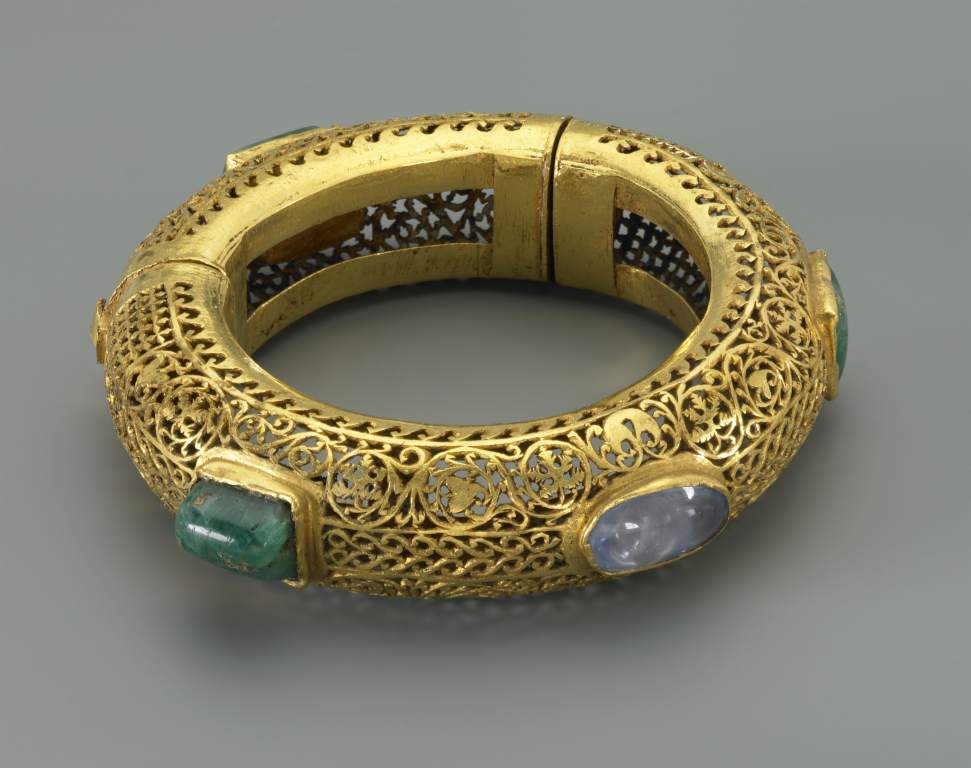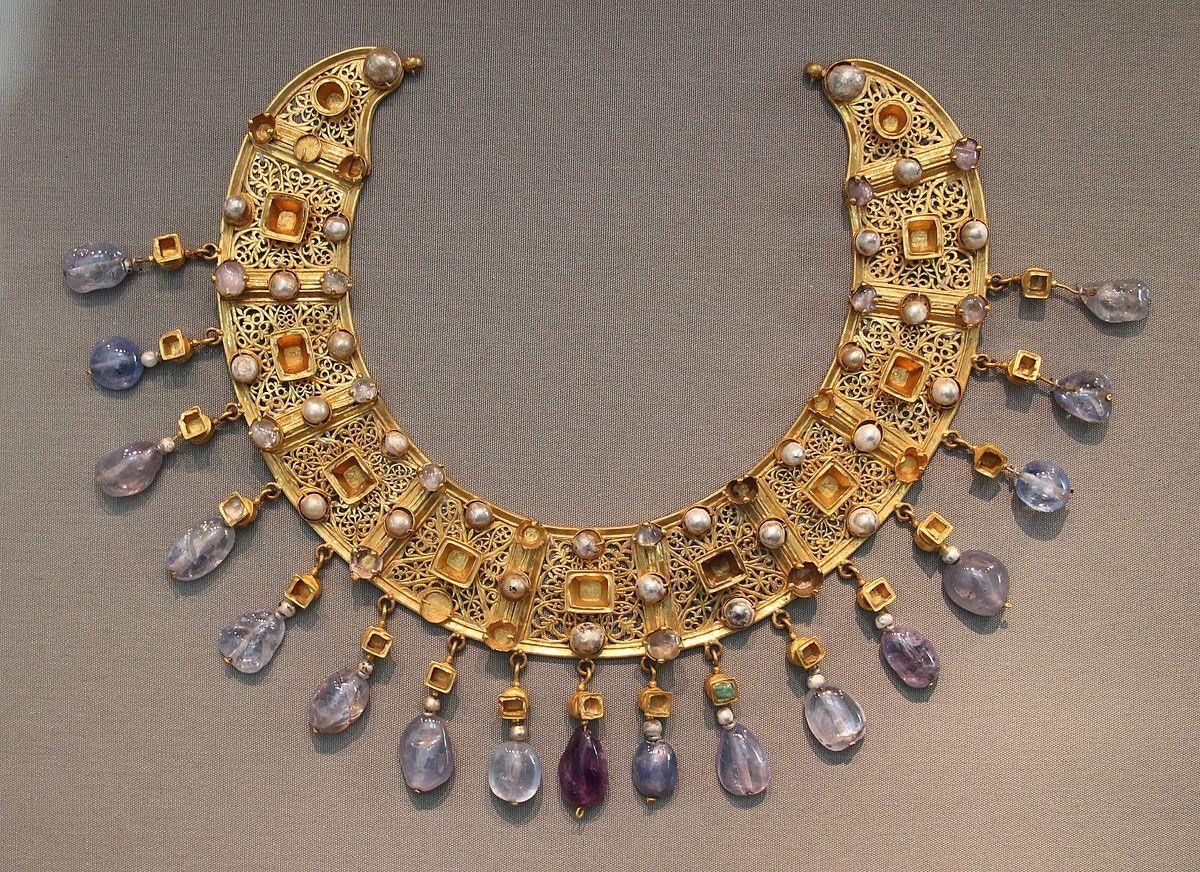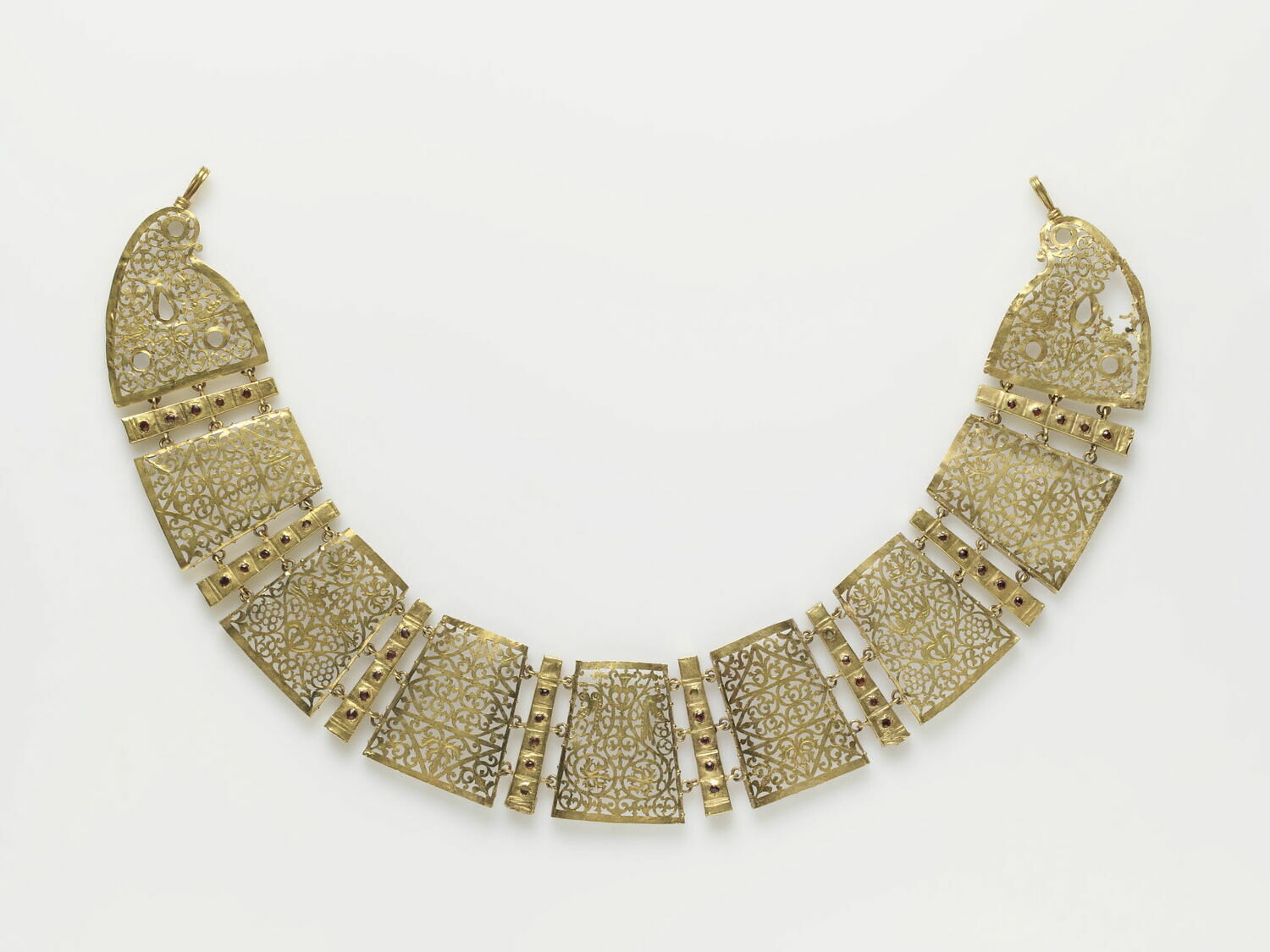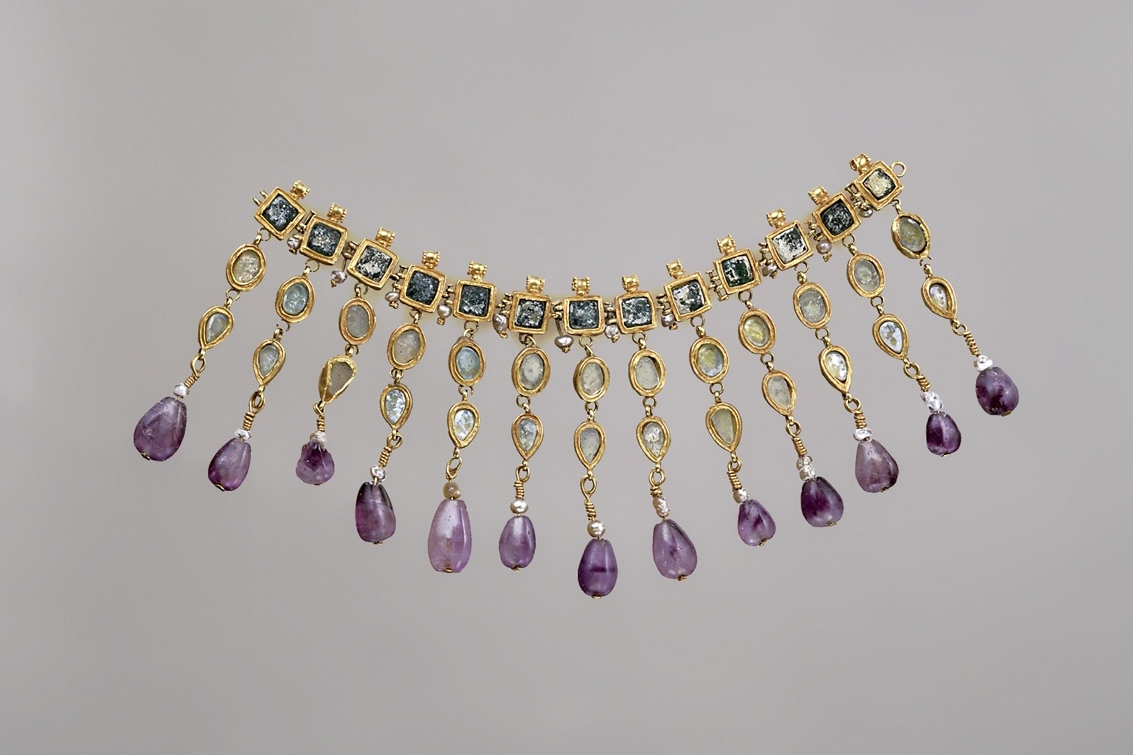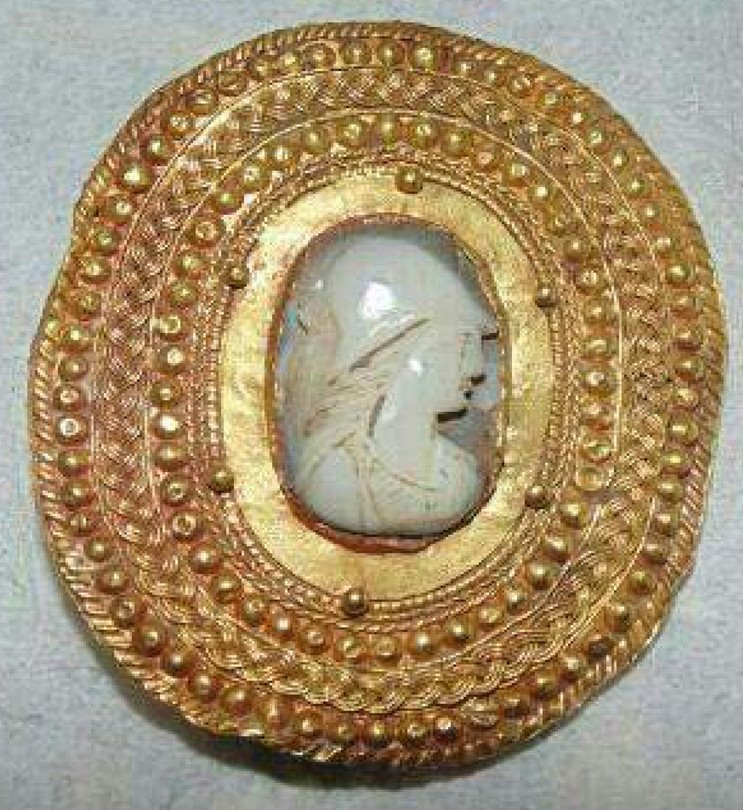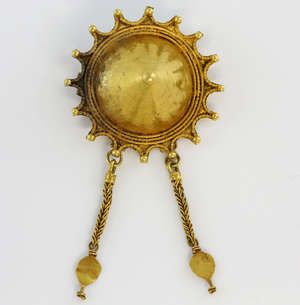
Source
Noel Adams “Back to Front: Observations on the development and production of decorated backing foils for garnet cloisonné”
“a fragmentary late antique ornament found in a tomb below the crypt of the church of San Francesco in Ravenna in 1879 (Fig 7; Ricci 1905, 39, 78, fig 153; Lipinsky 1961); sadly the piece is now lost. Seven hinged sections survived, consisting of narrow rectangular elements set with garnet plates; these alternate with larger links bearing oval garnets flanked by rows of pearls. The use of C-scrolls to separate the individual elements at the sides has much in common with late 4th-century goldwork (cf Deppert-Lippitz 1996, figs 23b and 26b) and the casings behind two of the larger sections bore stamped blossoms, rosettes and punching similar to those on the Piazza della Consolazione pendant. One of these bore a panel of imbricated feathers while the three smaller links were decorated with dotted crosshatching and scale patterns (Fig 7). The expanded repertoire of gold sheet motifs preserved on the San Francesco ornament corresponds to the Buckelarmringe decoration, revealing a continuing reliance upon a particular set of surface patterns.”

4th century necklace or a diadem [read more]
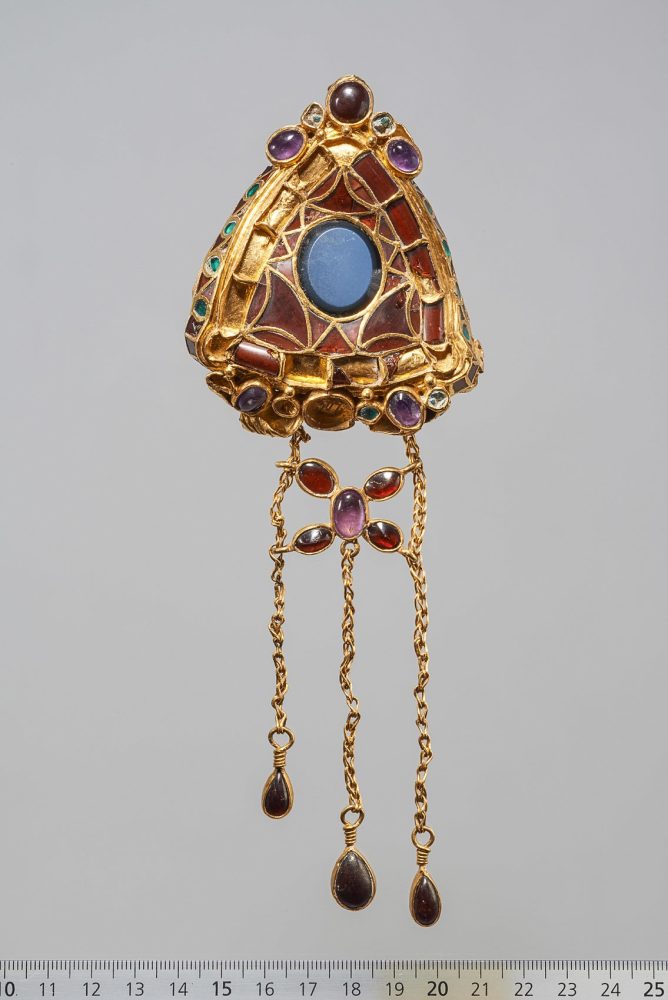
Brooch, 5th C; gold, garnet, amethyst, onyx, glass L 19,5 cm
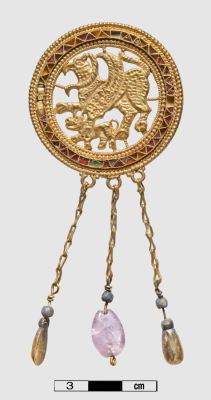
brooch, 5th-6th century https://colorsandstones.eu

BZ.1975.1 Dumbarton Oaks
http://colorsandstones.eu

575 – 625 CE
http://colorsandstones.eu
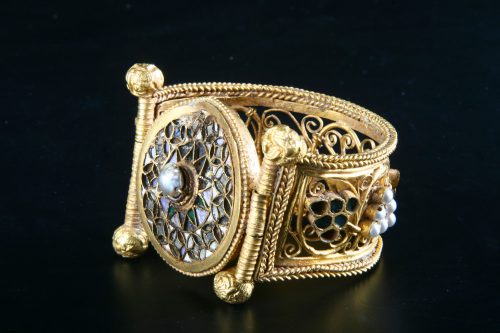
http://colorsandstones.eu

http://colorsandstones.eu

British Museum AF.351
http://colorsandstones.eu

http://colorsandstones.eu
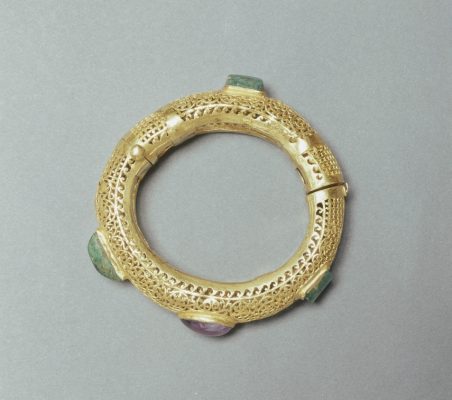
© Rheinisches Bildarchiv Köln
https://colorsandstones.eu

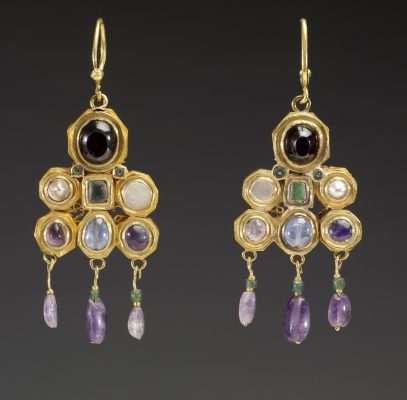
gold, pearls, semi-precious stones
Walters Art Museum, Baltimore

https://www.mediastorehouse.com
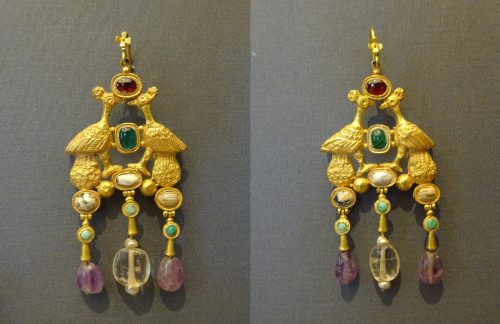
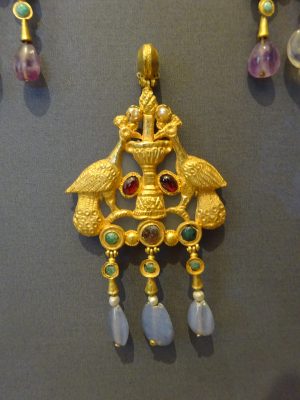
Pendant and earrings with Peacocks Made of gold with emeralds, sapphire, garnet, amethyst, crystal quartz, pearls & glass.
Byzantine, made in Constantinople; 500-600 CE.
On loan to the Getty Villa from a private collection [James and Elizabeth J. Ferrell]

http://colorsandstones.eu
Necklace from Lebanon National Museum, Beirut
5th-6th century



6th C Egypt
http://colorsandstones.eu

British Museum 1980,0501.1
http://colorsandstones.eu

http://colorsandstones.eu


© Museum of Cycladic Art, Inv. no. G 438.2
read more >> The Cypriot collection from the Museum of Cycladic Art in Athens

gold, pearls and semiprecious stones, Beirut, 5th-6th Century
read more



©Musée de Cluny 1. https://twitter.com/museecluny 2. https://www.musee-moyenage.fr

ARCHAEOMETRIC INVESTIGATION OF GARNET JEWELLERY
Archaeological material from Hungary (late 6th and 7th-century)
https://zellwerk.hypotheses.org/123
[an important website, garnet jewelery]

https://twitter.com/MuseoArcheoCa

early 5th century earrings, diam. 2 cm, gold, pearls, garnets
part of the Piazza della Consolazione treasure
Crescent–shaped earrings with lower ornamental band
LITERATURE:
- Crescent–shaped earrings with lower ornamental band; Peter Lango https://www.academia.edu
- Elegance Over the Borders: The Evidence of Middle Byzantine Earrings; Jenny Albani https://www.academia.edu
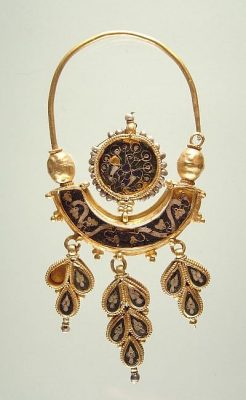
10th century Byzantine earring made of gold with pearls and cloisonné enamel, from Veliki Preslav treasure, Bulgaria.
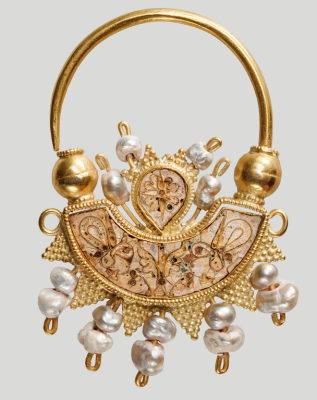
Crescent-shaped earring, 10th century, gold, pearls, and cloisonné enamel.
Heraklion, Historical Museum of Crete

Earring with Kufic inscriptions, first half of 10th century. Gold, pearls, and cloisonné enamel height: 4.8 x 3.6 cm. National Archaeological Museum, Stathatos Collection, Athens.
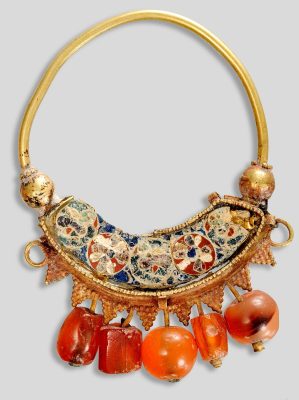
10th century earring.
Paul and Alexandra Kanelopoulos Museum, Athens.

https://www.numismaticadellostato.it/pns-pdf/notiziario/Notiziario_10_2017.pdf
“Paolo Orsi, Syracuse” regional archaeological museum. Gold earring purchased in Taormina in 1926
(inv. 45263). By concession of the Sicilian Region – Department of Cultural Heritage and Sicilian Identity.
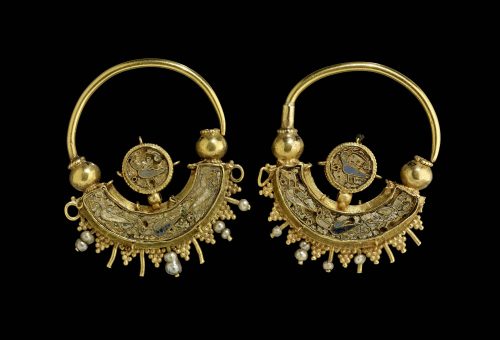
AF.338
10thC-11thC; ca 3.7 x 4.7 cm
“Pair of loop-earrings; gold and enamel; upper part a plain wire, springing from a hollow bead on each side; the lower a segment of circle filled on both sides with cloisonné enamel in blue, green and white; on one side three birds with twigs, on the other a bird between scrolls; on the outside edges, radiating pins with pearls, alternating with pyramids of pellets; a disc is fixed to the inner edge with similar enamelled decoration; on one side a bird with branch, on the other a flower; pearls have been threaded around the enamel, but the loops only remain.”
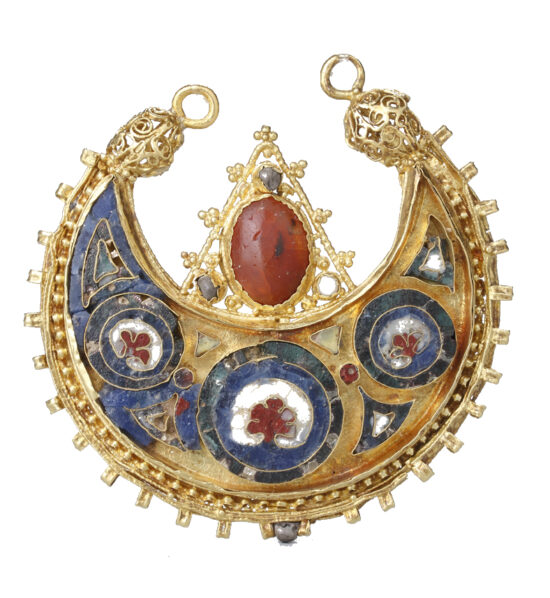
Small earring from Mainz, ca. 1050. Kunstgewerbe museum in Berlin


Middle Byzantine
first half of the 10th century
7.2 x 5.7 cm
gold with pearls
BZ.2021.001
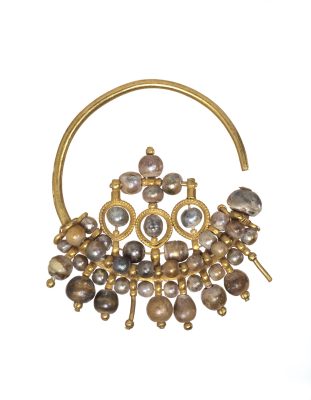

Earring or ornament for a diadem, Crete, first half of 10th century, gold, garnets, pearls, sapphires, emeralds, and glass, Athens, National Archaeological Museum, Stathatos Collection
SOURCES
- Византия сквозь века = Byzantium Through the Centuries; Yuri Pyatnitsky https://www.academia.edu
- The evidence for jewellery production in Constantinople in the early Byzantine period; Yvonne Petrina
https://www.academia.edu - Byzantine Jewellery? Amethyst beads in East and West during the Early Byzantine Period; Jörg Drauschke
https://www.academia.edu - Late antique and Early Medieval Female Headwear Ornaments from the Carpathian Basin (Veils, Hairnets and Headbands); Tivadar Vida https://www.academia.edu
- The evidence for jewellery production in Constantinople in the early Byzantine period; Yvonne Petrina https://www.academia.edu
- Byzantium and the West: Jewelry in the First Millennium (London, 2012), Jeffrey Spier https://www.academia.edu
- Notes on the Identification of an Earring with Monogram from the Benaki Museum in Athens, Georgi Sengalevich https://www.academia.edu
- Crescent–shaped earrings with lower ornamental band; Peter Lango https://www.academia.edu
- Elegance Over the Borders: The Evidence of Middle Byzantine Earrings; Jenny Albani https://www.academia.edu




